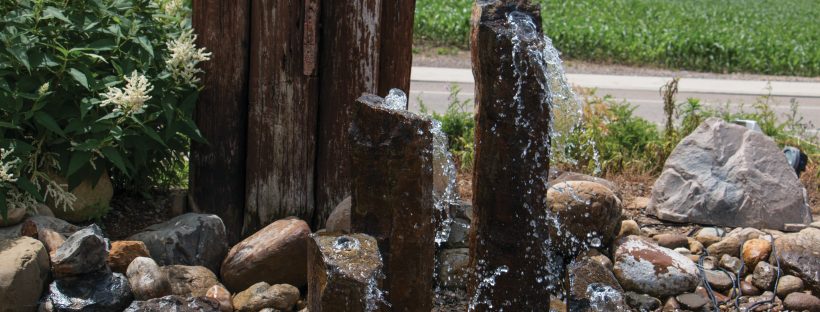
Look for the W.E.T.S. spots before you look for a leak!
One of the more confusing issues that pondowners and contractors have to deal with is the issue of “normal” water loss in what is supposed to be a closed system. Even if you’re 100% sure there are no leaks in your recirculating pond or fountain, the water level still drops. Why?
Well, the answer is that no outdoor water feature is really ‘closed’ at all. The natural processes of Wicking, Evaporation, Transpiration and Splash will cause water levels to drop. The amounts can be significant enough that they may seem to indicate a leak.
The question is, how do you tell the leak from these ‘normal’ water losses? This is especially important when a final payment depends on a ‘leak-free’ water feature. Although you may explain that some water will disappear even with no leaks until you’re blue in the face, concerned homeowners will often ask you to “prove it”. Hopefully this article will help.
Here are the four main ways water is going to leave a pond, pond-free feature or fountain no matter what you do:
Wicking
Wicking is where water is drawn out of the feature by absorbent materials like wood, soil, mulch, underlayment, even waterfall foam touching the water, is very common in natural-looking ponds and pond-free features. The same soft edge treatments that make them look natural can wick water away. In fact, some of the best and most attractive edge treatments depend on a certain amount of wicking, especially to help marginal plants thrive. However, standing water or really saturated soil won’t do the feature any good. Usually the cause of excessive wicking is a flap of underlayment or a blob of foam that’s allowing water to wick over the liner
It’s difficult to estimate how much water is wicked away in natural-looking features, but you can demonstrate it by sticking a twist of underlayment into a full bucket of water and letting it trail on the ground outside the bucket. Explain this often-beneficial process to your customer beforehand and let them know that some topping off will be necessary to keep their feature looking as lush and natural as possible. As you might imagine, wicking is less often a factor in fountains and hardscape features with ‘hard’ edges and few plantings.
Evaporation
Evaporation, unlike wicking, is often a significant factor in low-volume fountains and hardscape features, and sunlight, air temperature, water temperature, humidity, wind, splash and even wave action can make it worse. The way to roughly measure evaporation losses is relatively simple. Set a tub in an exposed location near the water feature. Fill it to the top and give it a couple of days, then measure the water loss. The water should drop at pretty much the same rate in the tub as it does in the water feature, all else being equal. Bear in mind that ponds will almost always drop more than just evaporation can account for, because of the other two processes, such as…
Transpiraiton
Transpiration, sometimes called plant breathing. Plants in water features can suck up and ‘exhale’ a significant amount of water in planted features. Of all the water absorbed by plants, less than 5% remains in the plant for growth. The rest is passed back into the atmosphere through pores on the underside of leaves. Corn, for example, transpires 99% of all the water it absorbs during its lifetime. Whatever the specific amount may be, expect greater water losses due to transpiration in heavily planted ponds.
Splash
Don’t forget about Splash! Any wet spots outside the pond liner – on stone, gravel, paving, vegetation, soil, mulch, etc – are lost water. To guestimate how much water you’re losing to splash, set a piece of paper towel on a wet spot. You may have to put something under the paper towel or shade it to keep the water from evaporating. After a set amount of time, squeeze the paper towel into a one-ounce sauce container like you find at fast food places, or weigh the paper towel to find the quantity of water using 1g = 1ml. Estimate the total quantity of paper towels you’d need to capture all the splash and do the math. I am always surprised at what it adds up to over a 24-hour period.

Shortcuts
A quick way to gauge what a water feature should be losing to the combined effects of evaporation and transpiration can be gleaned from charts like this one at the Northeast Regional Climate Center, Potential Evapotranspiration for Selected Locations, published by the National Regional Climate Center at Cornell University. These Monthly Average Potential Evapotranspiration (PET) Estimates are the theoretical maximum evapotranspiration possible off an unlimited supply of water, such as a lake or a water feature. Here on Long Island, I can expect to lose 4.41 inches (the reading at LaGuardia Airport) in the month of July, about one inch a week, just due to evaporation and transpiration. Once you add in wicking and splash, an average water loss of only a couple of inches a week is probably a guarantee that there is no leak at all.
So, before you start looking for the leak that’s causing that ¼” a day drop that your customer is so concerned about, check for the WETS spots and reassure them that it’s only natural.
About the Author:

DEMI FORTUNA
Demi has been in water garden construction since 1986. As Atlantic’s Director of Product Information, if he’s not building water features, he’s writing or talking about them. If you have a design or construction question, he’s the one to ask.


